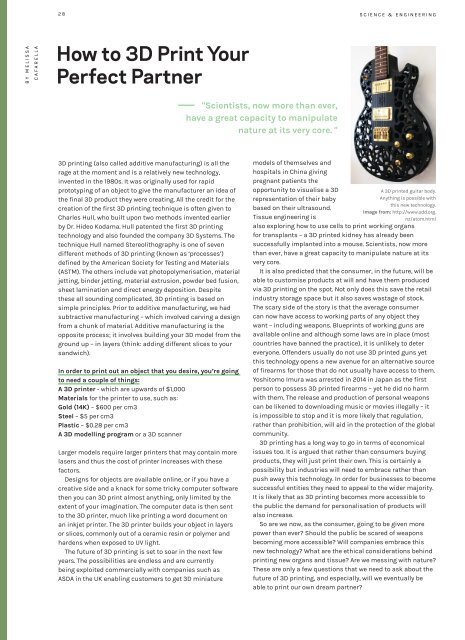You also want an ePaper? Increase the reach of your titles
YUMPU automatically turns print PDFs into web optimized ePapers that Google loves.
28<br />
SCIENCE & ENGINEERING<br />
BY MELISSA<br />
CAFARELLA<br />
How to 3D Print Your<br />
Perfect Partner<br />
"Scientists, now more than ever,<br />
have a great capacity to manipulate<br />
nature at its very core. "<br />
3D printing (also called additive manufacturing) is all the<br />
rage at the moment and is a relatively new technology,<br />
invented in the 1980s. It was originally used for rapid<br />
prototyping of an object to give the manufacturer an idea of<br />
the final 3D product they were creating. All the credit for the<br />
creation of the first 3D printing technique is often given to<br />
Charles Hull, who built upon two methods invented earlier<br />
by Dr. Hideo Kodama. Hull patented the first 3D printing<br />
technology and also founded the company 3D Systems. The<br />
technique Hull named Stereolithography is one of seven<br />
different methods of 3D printing (known as ‘processes’)<br />
defined by the American Society for Testing and Materials<br />
(ASTM). The others include vat photopolymerisation, material<br />
jetting, binder jetting, material extrusion, powder bed fusion,<br />
sheet lamination and direct energy deposition. Despite<br />
these all sounding complicated, 3D printing is based on<br />
simple principles. Prior to additive manufacturing, we had<br />
subtractive manufacturing – which involved carving a design<br />
from a chunk of material. Additive manufacturing is the<br />
opposite process; it involves building your 3D model from the<br />
ground up – in layers (think: adding different slices to your<br />
sandwich).<br />
In order to print out an object that you desire, you’re going<br />
to need a couple of things:<br />
A 3D printer - which are upwards of $1,000<br />
Materials for the printer to use, such as:<br />
Gold (14K) – $600 per cm3<br />
Steel – $5 per cm3<br />
Plastic – $0.28 per cm3<br />
A 3D modelling program or a 3D scanner<br />
Larger models require larger printers that may contain more<br />
lasers and thus the cost of printer increases with these<br />
factors.<br />
Designs for objects are available online, or if you have a<br />
creative side and a knack for some tricky computer software<br />
then you can 3D print almost anything, only limited by the<br />
extent of your imagination. The computer data is then sent<br />
to the 3D printer, much like printing a word document on<br />
an inkjet printer. The 3D printer builds your object in layers<br />
or slices, commonly out of a ceramic resin or polymer and<br />
hardens when exposed to UV light.<br />
The future of 3D printing is set to soar in the next few<br />
years. The possibilities are endless and are currently<br />
being exploited commercially with companies such as<br />
ASDA in the UK enabling customers to get 3D miniature<br />
models of themselves and<br />
hospitals in China giving<br />
pregnant patients the<br />
opportunity to visualise a 3D<br />
representation of their baby<br />
based on their ultrasound.<br />
Tissue engineering is<br />
A 3D printed guitar body.<br />
Anything is possible with<br />
this new technology.<br />
Image from: http://www.odd.org.<br />
nz/atom.html<br />
also exploring how to use cells to print working organs<br />
for transplants – a 3D printed kidney has already been<br />
successfully implanted into a mouse. Scientists, now more<br />
than ever, have a great capacity to manipulate nature at its<br />
very core.<br />
It is also predicted that the consumer, in the future, will be<br />
able to customise products at will and have them produced<br />
via 3D printing on the spot. Not only does this save the retail<br />
industry storage space but it also saves wastage of stock.<br />
The scary side of the story is that the average consumer<br />
can now have access to working parts of any object they<br />
want – including weapons. Blueprints of working guns are<br />
available online and although some laws are in place (most<br />
countries have banned the practice), it is unlikely to deter<br />
everyone. offenders usually do not use 3D printed guns yet<br />
this technology opens a new avenue for an alternative source<br />
of firearms for those that do not usually have access to them.<br />
Yoshitomo Imura was arrested in 2014 in Japan as the first<br />
person to possess 3D printed firearms – yet he did no harm<br />
with them. The release and production of personal weapons<br />
can be likened to downloading music or movies illegally – it<br />
is impossible to stop and it is more likely that regulation,<br />
rather than prohibition, will aid in the protection of the global<br />
community.<br />
3D printing has a long way to go in terms of economical<br />
issues too. It is argued that rather than consumers buying<br />
products, they will just print their own. This is certainly a<br />
possibility but industries will need to embrace rather than<br />
push away this technology. In order for businesses to become<br />
successful entities they need to appeal to the wider majority.<br />
It is likely that as 3D printing becomes more accessible to<br />
the public the demand for personalisation of products will<br />
also increase.<br />
So are we now, as the consumer, going to be given more<br />
power than ever? Should the public be scared of weapons<br />
becoming more accessible? Will companies embrace this<br />
new technology? What are the ethical considerations behind<br />
printing new organs and tissue? Are we messing with nature?<br />
These are only a few questions that we need to ask about the<br />
future of 3D printing, and especially, will we eventually be<br />
able to print our own dream partner?


















